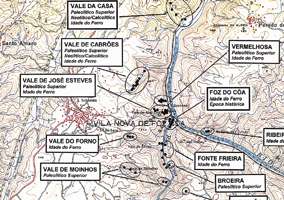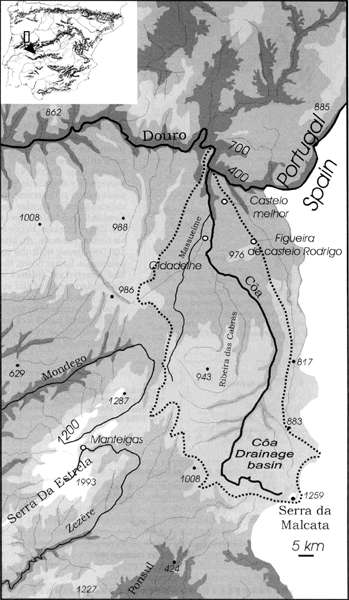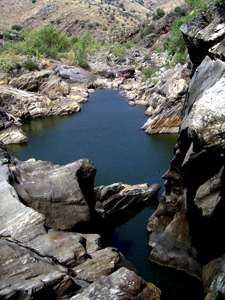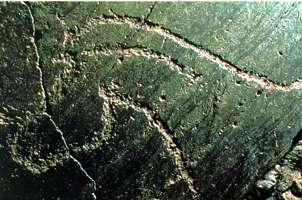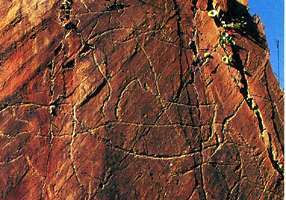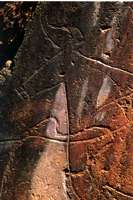Back to Don's Maps
Click on the photos to see an enlarged version
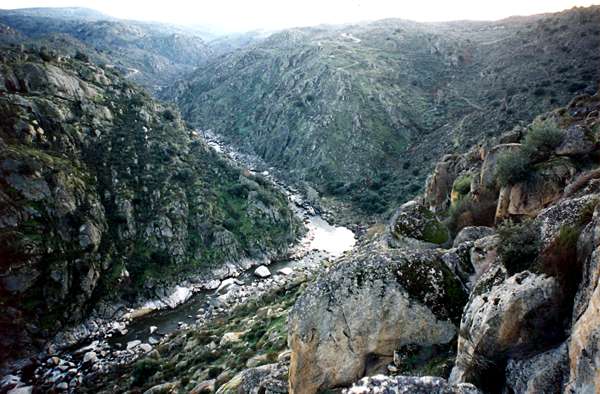
The Coa Valley
The Coa Valley has the most exceptional concentration of rock carvings from the Upper Palaeolithic. It is the most outstanding example of early human artistic activity in this form anywhere in the world, and has been designated a UNESCO world heritage site.Photo: Marcos Oliveira
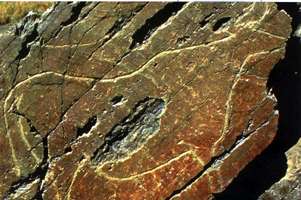
Photo: Canada do Inferno, Auroch - from a postcard by Ministério da Cultura, Parque Arqueológico do Vale do Coa
It should be noted at the outset that the Coa Valley rock art has consistently been dated at older than 20 000 years by those relying on stylistic evidence. It has been categorised as Solutrean in style.
Others have disputed such an early date.
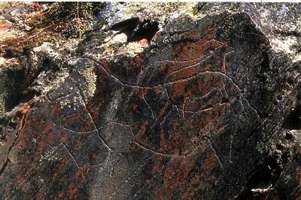
Photo: Penascosa, Horse and Goats (or Ibex)- from a postcard by Ministério da Cultura, Parque Arqueológico do Vale do Coa
A 2002 paper, Open-air Rock-art, territories and modes of exploitation during the Upper
Palaeolithic in the Coa Valley (Portugal), by Thierry Aubry, Xavier Mangado Llach, Jorge David Sampaio, Farid Sellami has settled the chronology in the favour of the 10 000 to 30 000 BP time frame, see the figure below.
In 1989, E.D.P. (Electricidade de Portugal) ordered an Environmental Impact Study to be carried out in the Coa valley, in preparation for the construction of a large dam to be located near the mouth of the river. In the framework of that study, a team of archaeologists made a preliminary survey of the area to record and evaluate the cultural heritage items that would be submerged or destroyed as a result of the construction of the dam. An important array of archaeological sites was identified, including four rock-shelters with prehistoric paintings.Text above from the official website of the Parque Arqueológico do Vale do Coa / Coa Valley Archaeological Park at: http://www.ipa.min-cultura.pt/coa
Map: Arte Rupestre e Pré-História do Vale do Coa trabalhos de 1995-1996,Coordenaçâo de Joâo Zilhão, Ministério da Cultura, Portugal, 1997.
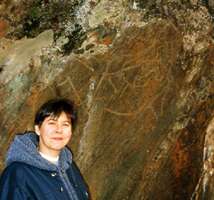
Rock 6 of Penascosa.
This is a good photo to show the scale of some of the engravings.
Photo: Marcos Oliveira
Passionate controversy immediately followed the public announcement of the existence of this soon-to-disappear complex of rock art sites. Massive national and international protest - conducted under the slogan Petroglyphs can't swim, derived, from a popular rap song, by the high-school students from the local town of Vila Nova de Foz Coa - eventually forced the Portuguese government to slow down construction work, which almost came to a halt in May 1995.Text above from the official website of the Parque Arqueológico do Vale do Coa / Coa Valley Archaeological Park at: http://www.ipa.min-cultura.pt/coa
In November 1995, recognising the importance of the cultural heritage of the region, the Portuguese government decided to halt the construction of the dam and to integrate this ensemble of finds into a Coa Valley Archaeological Park.
Map: Open-air Rock-art, territories and modes of exploitation during the Upper Palaeolithic in the Coa Valley (Portugal), by Thierry Aubry, Xavier Mangado Llach, Jorge David Sampaio, Farid Sellami. (PDF version, from http://www.ipa.min-cultura.pt/coa/)
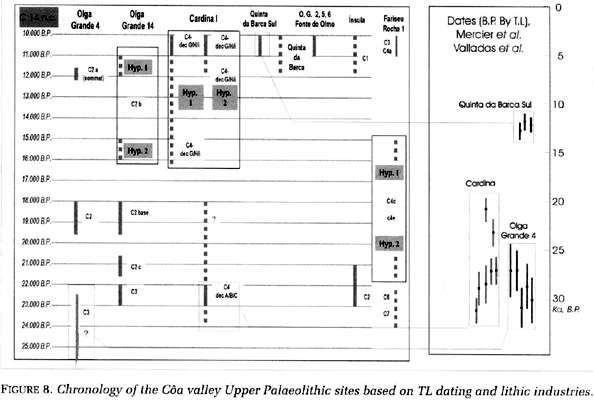
Chronology of several sites in the Coa Valley region.
Photo: Open-air Rock-art, territories and modes of exploitation during the Upper
Palaeolithic in the Coa Valley (Portugal), by Thierry Aubry, Xavier Mangado Llach, Jorge David Sampaio, Farid Sellami. (PDF version, from http://www.ipa.min-cultura.pt/coa/)
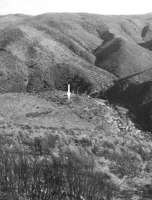
Salto do Boi, Cardina I.
A general view from the SW
to the NE. The arrow indicates the position of the jazida or archaeological dig.
Photo: Arte Rupestre e Pré-História do Vale do Coa trabalhos de
1995-1996,Coordenaçâo de Joâo Zilhão, Ministério da Cultura, Portugal,
1997.
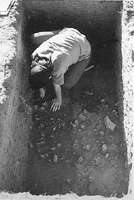
Salto do Boi, Cardina I.
A view of the dig in squares Q/15 - 16
Careful plans and records are made when a dig of this significance is made.
Photo: Arte Rupestre e Pré-História do Vale do Coa trabalhos de
1995-1996,Coordenaçâo de Joâo Zilhão, Ministério da Cultura, Portugal,
1997.
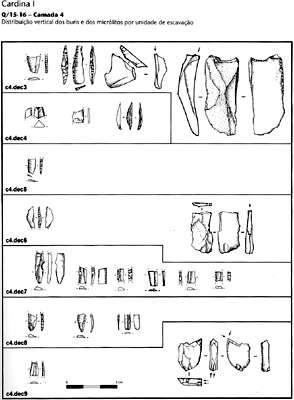
Drawings of artefacts found at Cardina I at Salto do Boi from squares Q/15 - 16.
Photo: Arte Rupestre e Pré-História do Vale do Coa trabalhos de
1995-1996,Coordenaçâo de Joâo Zilhão, Ministério da Cultura, Portugal,
1997.
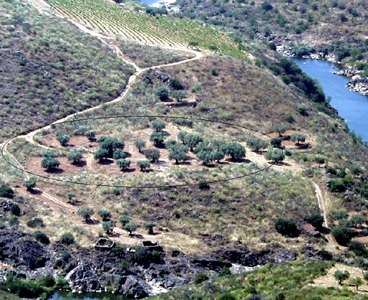
Salto do Boi, Cardina.
The site is on a shelf, a flat area ideal for a camp, in the inside of a right angled bend in the Coa River.
Photo: Parque Arqueológico do Vale do Coa IPA
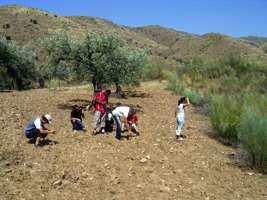
Salto do Boi, Cardina.
Archaeology students investigating the site shown in the long distance shot above.
Photo: Parque Arqueológico do Vale do Coa IPA
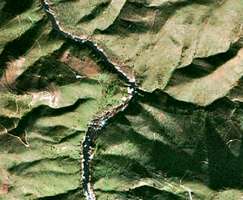
Salto do Boi, Cardina.
Photo: Google Earth
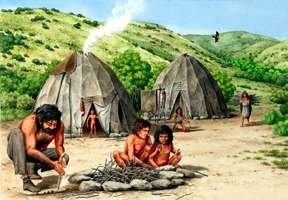
Salto do Boi, Cardina I.
Recreation of an encampment of the people of the Coa Valley at the Cardina I site. Marcos Oliveira has used photographs of the area and information from scientific investigations to recreate much of the daily lives of the people who lived here in the late Palaeolithic. This painting illustrates the Cardina I site shown in the photographs above where the remains of two huts with fireplaces were found.
The shape of the tents and their construction using saplings covered in hides were suggested to Mr Oliveira by the french archaeologist Thierry Aubry, who works in the Park (Parque Arqueológico do Vale do Coa - PAVC) as a result of his extensive knowledge of the digs in the area.
As might be expected, the Palaeolithic peoples of the Coa Valley chose flat, relatively extensive areas close to the river for their dwelling sites.
Artwork: Marcos Oliveira
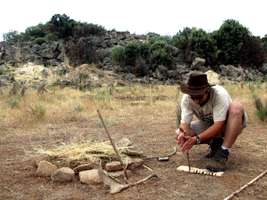
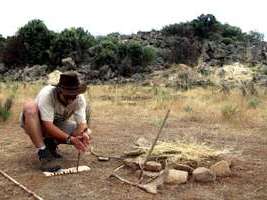
Starting a fire the old fashioned way, to use as the basis of the painting above.
Left: the original photo.
Right: the same photo flipped.
This method allows the artist to create very realistic paintings, with natural poses.
Photo: Parque Arqueológico do Vale do Coa IPA
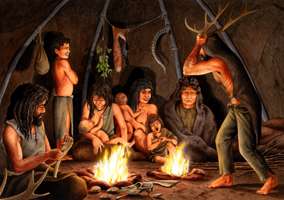
Salto do Boi, Cardina I.
A superb recreation of a night time scene inside of one of the tents, showing a shaman or a story teller with a family by firelight.
Artwork: Marcos Oliveira
The Coa River is a tributary of the Douro, the major river draining the northern slope of the central Iberian Cordillera. The river is 120 km long, and from the source to within 17 km of its confluence with the Douro, it has a narrow valley flowing through granitic rocks. The river then enters a zone of metamorphic rocks, and flows through a broader valley as it meanders to its meeting with the Douro.Text above adapted from:
The basin covers 2419 km2, and the average precipitation is 818 mm in the middle of the basin, but in the last part of the valley, below 150 m, precipitation is less than 300mm, giving a relatively arid environment. Winter temperatures drop as low as 5° in winter, rising to more than 35° in July and August.
Because of this environment, and because the soils are thin and ill suited for agriculture, mainly vines, olive and almond trees are grown in terrace cultivation, with supporting walls of low dry stone walls, to preserve the soils. Sheep and goats are also raised in the region.
Antiquity. 2002, 76: 62-76
Open-air Rock-art, territories and modes of exploitation during the Upper Palaeolithic in the Coa Valley (Portugal)
By Thierry Aubry, Xavier Mangado Llach, Jorge David Sampaio, Farid Sellami.
Photo: Parque Arqueológico do Vale do Coa IPA
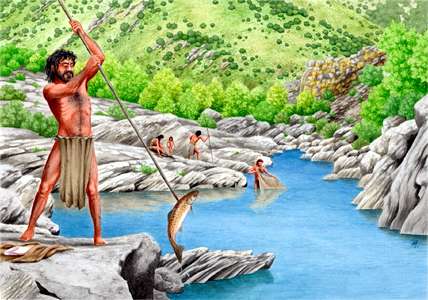
Salto do Boi, Cardina I.
Recreation of life in the Coa Valley, based on the photograph of the river gorge above. The man has just speared a salmon or trout (they belong to the same family, the salmonids) in the water, while another fisherman tries a net in the shallows.
The PAVC have identified bones of the Allis Shad, Alosa alosa of the family Clupeidae in the area, associated with Palaeolithic artefacts. Today there are brown trout in the river, but migratory large trout such as the sea trout are absent because of the many dams between the sea and this region.
Artwork: Marcos Oliveira
The text below is translated and adapted from a scientific paper on the website http://www.uc.pt/fozcoa/cardina.html
O sítio arqueológico paleolítico do Salto do Boi
(Cardina, Santa Comba, Vila Nova de Foz Coa)
by
João ZILHÃO, Thierry AUBRY, António FAUSTINO DE CARVALHO, Gertrudes ZAMBUJO, Francisco ALMEIDA
Photo: Canada do Inferno, Horse head - from a postcard by Ministério da Cultura, Parque Arqueológico do Vale do Coa
The archaeological site of the Salto do Boi is located on the left bank of the river Coa, about 500 m downstream from the mouth of the river Massueime, and is located about 3 kilometers upstream of the cores of rock carvings and engravings of Penascosa Quinta da Barca. The land in question, known locally as Cardina, is the property of sr. Fernando Augusto Baltazar, residing in the village of Melhor.
Photo: Canada do Inferno, Rock engraving - from a postcard by Ministério da Cultura, Parque Arqueológico do Vale do Coa
At this point, the Coa describes a tight curve, given the difficulties of overcoming on its northward journey an important geological accident: a crest of hard rock (granite) with a strike of E - W. The existing bottleneck at the point of crossing is the area of the valley where the distance between the two sides is small - only 10 m - and is the origin of the name by which the location is known. (?jumping the ox?)
Photo: Canada do Inferno, Detail of Rock engraving - from a postcard by Ministério da Cultura, Parque Arqueológico do Vale do Coa
They were identified and subjected to archaeological survey two distinct areas: Cardina I and II. They are flat platforms, the first at a height of of about 25 m above the bottom of the valley and the second about 10 m below that. In both cases the existing soil is used similarly for olive groves and grass and weeds are removed regularly, both for reasons of agriculture and for the prevention of fires. In recent years the weeding has been done by mechanical means, but always without breaching depths below about 15-20 cm. In relatively recent times, still in the memory of the owner, this whole area was also used for cereal production, and there are still visible in the area of Cardina II small retaining walls built to contain ploughed land in terraces.
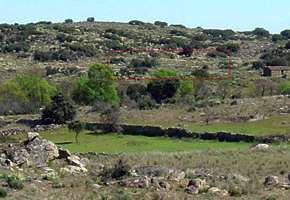
Olga Grande.
The red rectangles show the archaeological digs.
Photo: Parque Arqueológico do Vale do Coa IPA
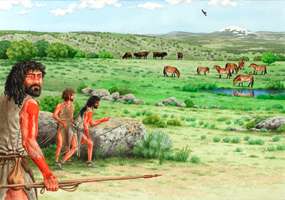
Illustration of hunters observing horses and aurochs preparatory to hunting them, at Olga Grande.
Artwork: Marcos Oliveira
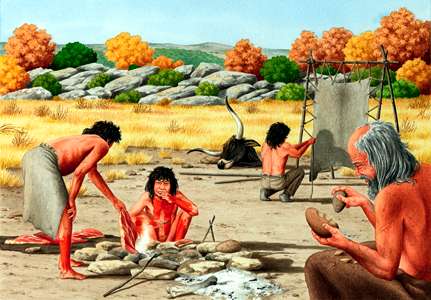
Olga Grande
After a successful hunt, there is very little of the aurochs that is not used. The skin is stretched on a frame, and is prepared for further use. Sharp tools are always needed, and new ones must be prepared quickly and efficiently to replace those lost or dulled with use. The aurochs steaks look pretty good!
Artwork: Marcos Oliveira
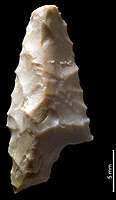
A shouldered point from the Coa Valley, one which has been carefully made to accept the end of the haft of a spear to make binding the point onto the spear easier. The sharp end of this point has been broken off during use.
Photo: Parque Arqueológico do Vale do Coa IPA
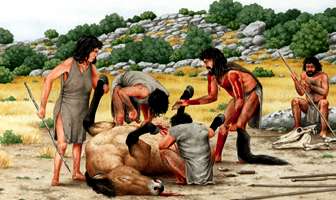
Illustration of the butchering of a horse in palaeolithic times in the Coa Valley, at Olga Grande. The site is littered with thousands of artefacts which attest to this use by the Palaeolithic inhabitants.
There are many examples of horse engravings in the Coa Valley.
Artwork: Marcos Oliveira
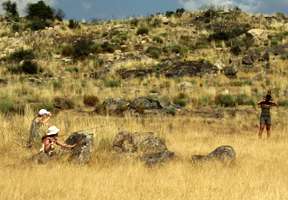
This photograph was set up to illustrate hunting in the Coa valley. Volunteers have makeshift spears at the ready while hunting a "deer".
Photo: Parque Arqueológico do Vale do Coa IPA
The species represented in the art of the Coa Valley are: Auroch (Bos primigenius), Horse (Equus cabalus), Elk (Cervus elaphus) and Spanish Ibex (Capra pyrenaica), there is also one fish (an unidentified species) and one human figure.
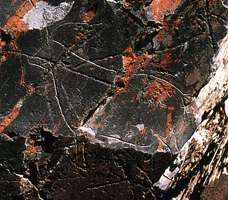
Photo: Penascosa, Ibex - from a postcard by Ministério da Cultura, Parque Arqueológico do Vale do Coa
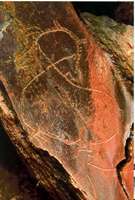
Photo: Quinta da Barca, Three goats - from a postcard by Ministério da Cultura, Parque Arqueológico do Vale do Coa
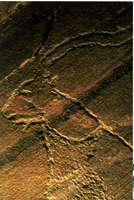
Photo: Rego da Vide, Ibex, detail - from a postcard by Ministério da Cultura, Parque Arqueológico do Vale do Coa
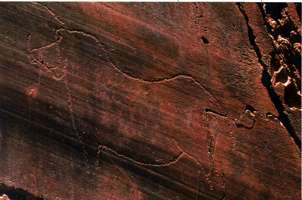
Photo: Ribeira de Piscos, Horses - from a postcard by Ministério da Cultura, Parque Arqueológico do Vale do Coa
These are some common snakes of Portugal, some of which no doubt lived in this area in Palaeolithic times.
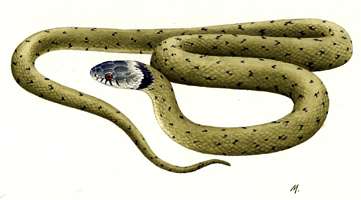
Natrix natrix
The Grass Snake (Natrix natrix) is the best known european snake. It is widespread throughout Europe and occurs from England to Russia, from Portugal to Finland. Only decades ago, this reptile was very common, especially in habitats associated with water. But in our days such natural habitats are rare, at least in congested urban areas. Grass snakes feed on amphibians, fish, small mammals and, to a lesser degree, on young birds. Mature females can be up to 200 cm long, but usually reach a length of 100 - 150 cm. The males are smaller. The typical characteristic of central european subspecies is the yellowish or white 'half-moon' on both sides of the neck. The body colouration is variable, most specimens are grey or olive green with dark spots or bars along their sides. Needless to say, N. natrix is harmless.
Text: http://www.oeko-msc.de/rept3-en.htm
Artwork: Marcos Oliveira
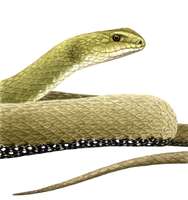
Malpolon monspessulanus
The Montepellier snake (Malpolon monspessulanus) is found from northern Italy to southern France, the Iberian peninsula and northwest Africa. This snake is rear-fanged with 2 enlarged teeth in the back of its mouth, from where poison can be injected to the bite. A normal bite from this snake is not harmful because of the position of these teeth, but the poison is potent and will cause swellings, pain and even fever for a couple of hours. The Montepellier snake is up to 2 metres long, and animals above 150 cm are common. The nominate form has a blackish front body. They are normally brown or green but even red, black or turkish-blue coloured forms are found. Juveniles are light coloured with darker saddles or spots on the back. They have a large head and large "eyebrows" making them look angry. This snake is protected in Europe under the Berne Convention.
Text: http://www.reptilia.dk/Krybdyr_vi_holder_nu/Slanger/Malpolon/malpolonmonspessulanus.htm
Artwork: Marcos Oliveira
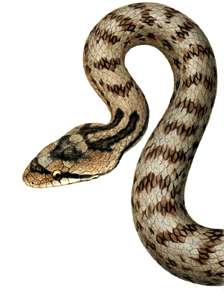
Coronella girondica
The Southern Smooth Snake is small in size, with a small head and a relatively short tail. The back and sides are usually grey or brown in colour, with a transverse row of spots on the back. On the belly there are often dark square spots in a checkerboard design. It is likely that the species arose in the Iberian peninsula.
It is distributed across the Iberian peninsula, northwest Africa, and southwest Europe including southern France and northern and central Italy.
Their main prey are lizards, including in their diet to a lesser extent eggs of reptiles, small mammals, birds and chickens. They are active at dusk looking for their prey.
Text: Translated and adapted from http://www.vertebradosibericos.org/reptiles/corgir.html
Artwork: Marcos Oliveira
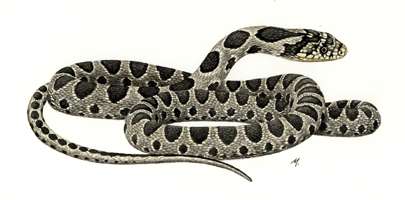
Coluber hippocrepis
The Horseshoe Snake.
Coluber hippocrepis lives in the southwestern corner of Europe and the northwestern part of Africa. Maximum size is about 150 cm but adults are normally about 120 cm. It is one of the prettiest snakes of Europe, but especially the animals from Morrocco are very colourful. They normally prey on other reptiles, but will after a time in captivity accept rodents as food.
These very active snakes prefer a hot and dry environment.
Text: http://www.reptilia.dk/Krybdyr_vi_holder_nu/Slanger/Coluber_hippocrepis/bcoluberhippocrepis.htm
Artwork: Marcos Oliveira
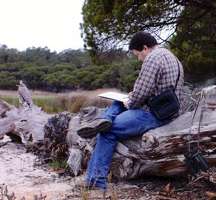
Marcos Oliveira is a scientific illustrator who lives in Lisbon, Portugal. He has completed several valuable paintings of people in the Coa Valley in the Palaeolithic, which give a very good idea of what life in those times was like.
He may be contacted via his website at
www.marcosoliveira.pt.vu
or via email at marcos.oliveira1@sapo.pt
Photo: Marcos Oliveira, from his website.
